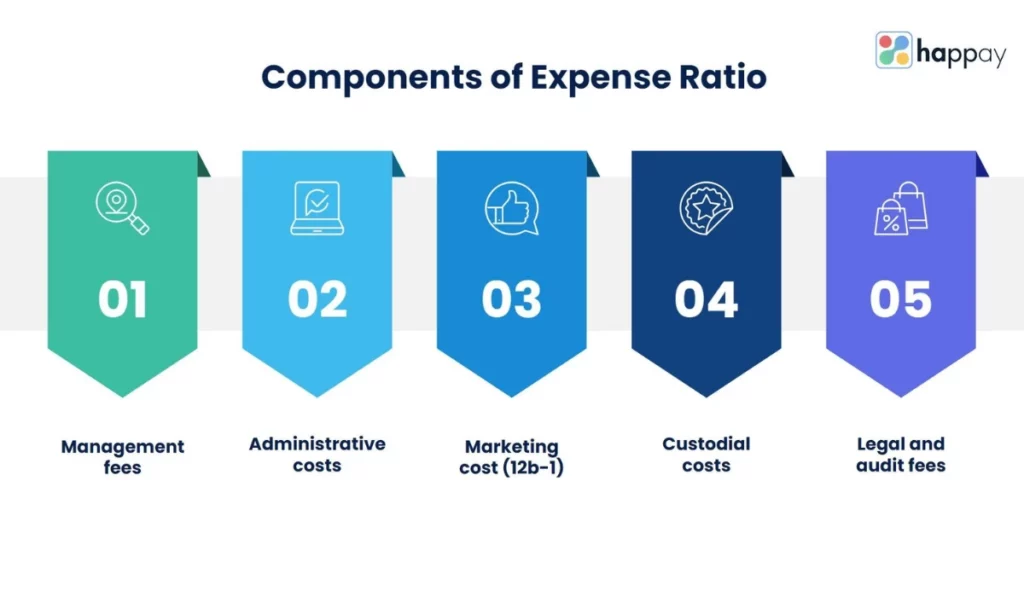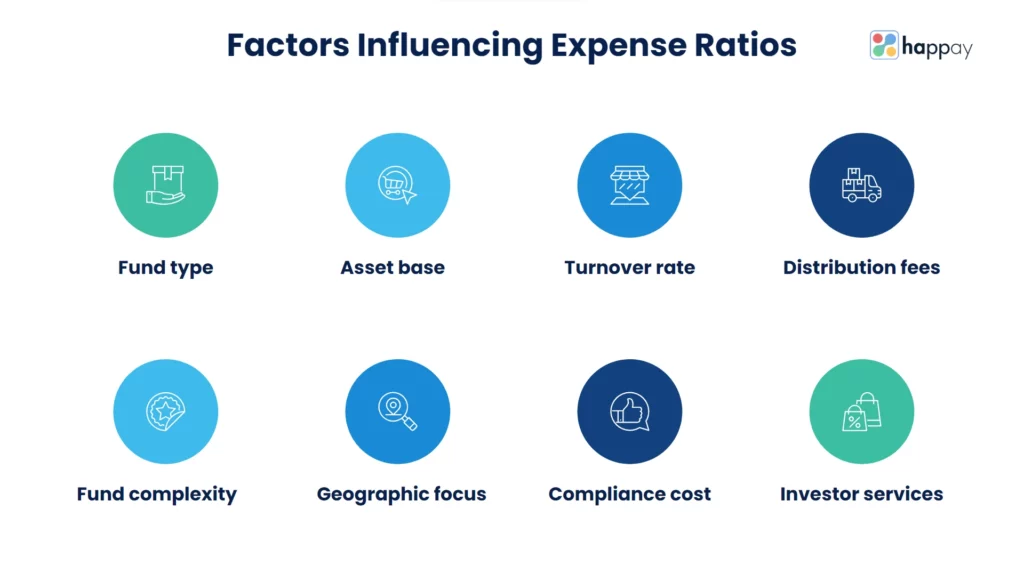Last Updated on November 28, 2025
Introduction
Clarity about cost is paramount for an investor.
The expense ratio tells them how much it costs to manage a fund. It’s often overlooked. Still, it’s one of the vital differentiators in investment decisions. You will find it expressed as a percentage.
The expense ratio significantly impacts returns, making it an attention driver for people looking to make money from mutual and exchange-traded funds. Let’s dive deeper into navigating expense ratio effectively while understanding its intricacies.
What is an expense ratio?
An expense ratio is used primarily in mutual fund and exchange-traded fund (ETF) industries. It represents the percentage of a fund’s average assets used for annual operating expenses.
It captures the yearly cost associated with managing and operating an investment fund. Since it’s deducted directly from the investment fund, it reduces the return to investors.
You can calculate the ratio by dividing the fund’s operating expenses by its average asset under management (AUM).
Also, Read: What are Non-operating Expenses? – Definition, Calculation and Examples
Importance of expense ratio in investment decisions
Expense ratio plays a crucial role in making investment decisions. It represents the cost of managing and operating a mutual fund or ETF. It has a direct impact on returns. A higher expense ratio can reduce returns over time. For example, a fund with 8% returns will yield 7% to the investor when the expense ratio is 1%.
Slight differences in the ratio can significantly impact the final numbers due to compounding. If you think a higher expense ratio means better fund performance, think again. No-cost index funds have performed better than actively managed funds in several timeframes.
Regardless of the grey areas, the expense ratio helps investors make informed decisions. They are aware of the actual cost associated with an investment.
Most importantly, it adds transparency and helps them compare.
When investors know the costs associated with their investments, they may be less likely to trade frequently.
High-frequency trading can erode returns, primarily if other costs like load or redemption fees are associated with the trades.
When evaluating an investment, consider other factors like strategy, performance, goals, and risk tolerance capability. The expense ratio as a standalone factor might show you half of the story. The other half unveils when you base the decision while examining all elements together.
Read More: Liquidity Ratios: Definition, Types, Formulas and Calculations
Components of expense ratio
The expense ratio represents the cost of managing a fund. This cost can be further broken down into components mentioned below.

1. Management fees
Fund managers charge a fee for their expertise in choosing and managing the fund’s investment portfolio. The fees are higher for actively managed funds as they involve crucial decision-making about buying or selling assets.
Investment management fees are the most significant component of the expense ratio.
2. Administrative costs
These are operational costs. They include salaries of non-management people, technology and services costs, and infrastructure costs, among others. These costs are indispensable for the fund’s daily operations.
Administrative costs are operating expenses incurred regardless of the fund’s performance.
3. 12b-1 fees
12b-1 fees are charged to cover marketing and distribution expenses. Mutual funds’ stakeholders pay it annually to the respective fund’s broker or advisor. This fee is a little controversial, as investors pay the fund house to market their funds and increase their customer base.
They were made legal after introducing the Investment Company Act of 1940 section. 12b-1 fees usually fall in 0.25% – 0.75% of the fund’s assets.
4. Custodial costs
These are the fees associated with holding and safeguarding the fund’s assets by a third-party custodial service. Custodians ensure the fund’s assets are securely held and the necessary record-keeping is accurate.
5. Legal and audit fees
These costs are associated with legal consultations and auditing services. Every fund requires legal guidance for compliance with regulations. Periodic audits ensure transparency and trustworthiness in a fund’s reporting.
6. Other expenses
Expenses that don’t fit into the above categories are included in other expenses. These costs include brokerage fees for trades made within the fund or fees related to borrowing.
While making an investment decision, consider these expenses and invest thoughtfully in funds that align with your goals. Refer to the funds’ annual report for a detailed breakdown of the expense ratio components.
Read More: Prepaid Expenses: Definition, Importance, Types & Examples
Expense ratio formula
It’s the cost you pay to keep the fund operational. Let’s dive into the basics, starting with the formula:
Total Expense ratio = Total Annual Fund Operating Expenses ÷ Average Annual Net Assets
Total annual fund operating expenses are the total costs a fund incurs in a year. It includes every expense ranging from management salaries to rent and marketing costs.
On the other hand, average annual net assets mean the average value of the fund’s assets in the year minus any liabilities.
Simply put, it’s the fund’s net worth averaged over a year.
How to calculate expense ratio?
Divide total expense by the average assets. You get a percentage that tells you how much of the fund’s assets are used annually by expenses.
These expenses include management fees, administrative fees, 12b-1 fees, custodial costs, legal fees, and other expenses.
Expense ratio representation
This ratio is represented as a percentage.
Simply put, a 0.50% expense ratio means for every $1000 you have invested in a fund, you’ll pay $5 annually toward the fund’s expenses. These costs are automatically deducted. They are reflected in the fund’s daily net asset value (NAV).
Quick Read: What are Business Expenses: A Complete Guide
Example of expense ratios
Suppose you’re considering investing in three different mutual funds: Fund A, Fund B, and Fund C. Each has its expense ratio:
Fund A: 0.10% (often referred to as ten basis points)
Fund B: 0.75% (or 75 basis points)
Fund C: 1.50% (or 150 basis points)
Let’s say you plan to invest $10,000 in one of these funds.
Calculating annual fees
To calculate the annual fee you’d pay for each fund based on its expense ratio:
- Fund A: $10,000 \times \frac{0.10}{100} = $10
- Fund B: $10,000 \times \frac{0.75}{100} = $75
- Fund C: $10,000 \times \frac{1.50}{100} = $150
This means you’ll pay $10, $75, and $150 per year for every $10,000 invested in Fund A, B, and C.
From a cost perspective, Fund A is the cheapest option, while Fund C is the most expensive. Over the long run, these cost differences can significantly impact net returns. Fund A will provide the highest net return to the investor if all three funds offer the same gross returns before fees due to its low expense ratio, while Fund C will provide the lowest.
Quick Read: How do Companies Manage their Employees’ Remote Work Expenses?
Factors influencing expense ratios
Several factors can influence the ratios for mutual funds or ETFs. Here’s a breakdown.

- Fund type. Actively managed funds have a higher expense ratio as compared to passively managed funds (index funds). Active funds require more hands-on management, incurring relatively higher costs. In the same way, equity funds have a higher expense ratio as stocks are more expensive to trade and require research.
- Asset base. More significant funds can spread their operating expense over a large asset base, reducing the expense ratio.
- Turnover rate. With a high trading frequency, funds incur higher transaction costs. These can indirectly influence the expense ratio.
- Distribution and service fees. With a higher 12b-1 fee, the expense ratio is higher.
- Fund complexity. Funds with a complex investment strategy (in derivatives, commodities, or real estate) require unique expertise. They have a higher expense ratio due to the need for specialized management.
- Geographic focus. Funds making investments in foreign markets have a higher expense ratio due to currency risk and the need for extensive research.
- Regulatory and compliance cost. The expense ratio can vary based on the region’s jurisdiction where the fund operates.
- Investor services. Some funds might offer additional services such as financial planning, increasing management fees, and expense ratios.
Moreover, a fund’s age also makes a difference. Newer funds might initially have higher expense ratios because they haven’t yet achieved economies of scale. As they attract more assets, their expense ratios might decrease.
Learn About: SG&A Selling, General and Administrative Expenses
The impact of expense ratios on returns
Although expense ratios erode small returns from funds, they might lead to significant decreases in return on investment over a more extended period. It’s true, considering the effect of compounding.
Over short periods, the difference might seem negligible. Still, over long durations like 20, 30, or even 40 years, the difference between high and low expense ratios can mean the difference of tens or even hundreds of thousands of dollars in potential earnings.
Let’s consider a scenario. Suppose you invest $ 100,000 in two funds, averaging a 7% annual return before expense over 30 years. Fund A and B have an expense ratio of 0.50% and 1.50%, respectively.
After 30 years:
- Fund A gives a net annual return of 6.5%. After 30 years, your investments grow to approximately $661,439.
- Fund B gives a net annual return of 5.50%. After 30 years, it would grow to approximately. $502,257.
For a 1% high expense ratio, you lose $159,000, even if both funds perform identically before the fees.
Compound effect of expense on overall portfolio value over time
Compounding can work for and even against you. It magnifies returns when reinvesting dividends or interest. At the same time, it can amplify a fee’s adverse effects over a long period.
Every dollar you pay in fees is one that’s not invested. Over time, you lose the dollar and all future earnings that could have come with it. Simply put, the real cost of a 1% fee isn’t just 1% of your assets. It’s the lost growth potential of assets over time.
In the long run, a seemingly small difference in expense ratios can lead to a significant disparity in portfolio value. It underscores the importance of being cost-conscious while making investment decisions and periodically reviewing and optimizing your portfolio to minimize unnecessary costs.
Learn About: Expense Reconciliation: A Guide to Reconcile Your Expenses
Expense ratio variations
We saw the factors that influence the ratios in the above sections. The same factors are responsible for the variations.
1. What increases expense ratios?
The factors below contribute to a high expense ratio. Summarizing them since we have already discussed them in detail in the above sections.
- Active management
- Specialized or niche strategies
- Fund size
- High turnover
- Additional investor service
- Challenges in emerging market
2. What decreases expense ratios?
Let’s look at what makes up for a low expense ratio in mutual funds or ETFs.
- Passive management. Some funds don’t require active decision-making for asset selection. They have lower expense ratios.
- Simplified investment strategies. Funds with a simple investment strategy, such as investing in a broad market index, can operate with lower costs.
- Technological advancements. Automation and technology streamline a fund’s operation, reducing costs.
- Market competition. Mature markets have a competitive landscape, which drives the expense ratios down. Advanced infrastructure and environments also aid in this.
Summing up, there are several reasons for variations in expense ratios. Investopedia suggests 0.5% to 0.75% is a reasonable expense ratio for an actively managed fund. An expense ratio of more than 1.5% is on the higher side.
You’ll also find the expense ratio for mutual funds is typically higher than that of ETFs since they’re passively managed.
Quick Read: Payroll Expense: A Comprehensive Guide
How to evaluate expense ratios?
Understanding how to evaluate expense ratios correctly can significantly impact your investment decisions, potentially saving you a significant amount in fees over the long run.
1. Use expense ratio to compare funds in the same category
Expense ratios can vary based on the category. For example, an equity large-cap fund will have a different expense ratio than a sector-specific small-cap fund.
It’s good to compare the expense ratio with an average or benchmark in the industry. Measure the expense ratio against a simple average to see how it ranks. However, measuring it against asset-weighted averages helps you discover what other investors pay for their funds. Ideally, you should consider investing in a fund below the asset-weighted average.
2. Use expense ratio in conjunction with other factors
Below are other factors you should consider while making an investment decision.
- Fund performance: A fund with a higher expense ratio might be justifiable if it consistently outperforms its peers and benchmarks after fees. However, research often shows that fewer active managers consistently beat their benchmarks, making low-cost index funds or ETFs attractive for many investors.
- Management quality: Consider the reputation and track record of the fund’s management team. Experienced and well-regarded managers might command higher fees but could also deliver value through better performance.
- Turnover rate: A high turnover rate can lead to higher transaction costs, which the expense ratio might not always reflect. Therefore, a fund with a low expense ratio but high turnover might cost more than anticipated.
- Additional fees: Apart from the expense ratio, there could be other fees, like sales or redemption. Ensure to look at the total cost of ownership.
3. Use tools to compare expense ratios
You can use the Financial Industry Regulatory Authority (FINRA) Fund Analyzer to analyze over 18,000 mutual funds, ETFs, and more. While doing the analysis, you should consider the parameters below before making an investment decision.
- Compare the fund’s performance: Each mutual fund scheme has a benchmark index. Compare the fund against the benchmark. A fund that constantly beats its benchmark would be an ideal investment.
- Consider expense ratios: Look for expense ratios lower than the asset-weighted average. According to SEBI guidelines, an expense ratio cannot be more than 2.25% of the fund’s AUM.
- Compare fund history: Analyze a fund’s history over a period of 5 to 10 years. Look how the fund performs in bear and bull cycles to validate your understanding.
- Evaluate the portfolio’s strength: You can use other financial ratios like Alpha and Beta. The Alpha ratio measures extra returns generated over the benchmark. On the other hand, Beta measures the volatility.
- Check for a fund’s maturity period: The maturity period is relevant for debt funds. These funds are sensitive to fluctuations in the market.
- Understand the risk-adjusted returns: Measure the risk using standard deviation and see how a scheme performs during market volatility. You can use the Sharpe ratio to analyze additional returns generated on each additional unit of risk taken.
You can use a brokerage platform to compare different funds based on the above factors.
Read More: Financial Analysis: What is it, Types, Objectives, Limitations & Tools
The trade-off: expense ratio vs. fund performance
The relationship between expense ratios and fund performance has been debated among investors. While logically, it might seem that paying more should result in better service or outcomes (in this case, superior fund management and returns), the dynamics don’t always align with this intuition.
Paying higher expense ratio vs. potential returns
Actively managed funds tend to have higher expense ratios. They employ financial professionals who dedicate their time to research, analysis, and active trading. The premise is that their expertise can navigate market complexities and potentially outperform passive strategies.
Some funds might adopt niche or specialized investment strategies, which demand a premium for the uniqueness and potential for higher returns. Proponents argue that active management can better mitigate risks during market downturns, justifying the higher expense ratio.
In a separate vein, actively managed funds don’t necessarily outperform their benchmarks over a long period, especially after considering the fees. Then, there is the effect of compounding, which erodes a significant portion of return on investment.
This doesn’t negate the value of active management in specific contexts or that some active managers consistently beat their benchmarks. Still, from a probability standpoint, the expense ratio and performance trade-off often favor low-cost funds.
Read About: TOP 10 Financial Planning Tools That Accelerate Growth
Expense ratios in different types of funds
Expense ratios can vary widely depending on the type of fund. Here’s a breakdown of expense ratios in different kinds of funds.
- Actively managed mutual funds: The expense ratio rarely exceeds 2.5%. The average expense ratio is between 0.5% and 1.0%.
- Passive index funds: Expense ratios are often on the lower side. A typical expense ratio for passive index funds is 0.2%.
- Exchange-traded funds: The expense ratio is typically lower but can vary. Typically, they have an expense ratio of less than 1%.
- Sector and specialty funds: The expense ratio of such funds can be higher since they focus on a specific sector like technology or healthcare while employing niche strategies.
- International and emerging market funds: They have a higher expense ratio as they often involve navigating complexities, foreign regulations, or less liquid markets.
- Money market funds: These funds invest in short-term, high-quality securities like Treasury bills. The investments are relatively straightforward, which can lead to lower operational costs. HDFC money market fund has an expense ratio of 0.41%.
- Target-date funds: The expense ratio of target-date funds can vary. These funds automatically adjust the asset mix based on a selected retirement date. The expense ratio often depends on the underlying funds in which they invest. If the target-date fund invests in higher-cost active funds, its expense ratio will be higher, and vice versa.
- Alternative funds: These have a higher expense ratio but use a different fee structure. Alternative funds include hedge funds, private equity, and others. These funds employ alternative strategies and may invest in non-traditional assets. Due to their unique and complex nature, operational costs can be significantly higher. They often charge a management fee (similar to an expense ratio) and a performance fee.
Learn More: Financial Modelling: Types, Process, Components and Software
Active vs. Passive Funds: A comparison of typical expense ratios
Attributes |
Active funds |
Passive funds |
Objective |
Outperform a benchmark by selecting individual stocks or bonds |
Match a benchmark index by holding all or a representative sample of its constituents. |
Management style |
Managers actively pick stocks based on market research and forecasts, and their judgment |
Automated or follows a set of formulas. Mimics the holdings of an index. |
Expense ratios |
0.5% to 2.0% |
0.02% to 0.5% |
Trading costs |
Higher, due to frequent changes in holdings |
Typically lower due to less trading frequency |
Potential for outperformance |
Yes |
No |
Performance consistency |
Varies significantly between different active funds |
Typically closely matches the performance of the benchmark index |
Strategies to minimize expense ratio impact
Minimizing expense ratios’ impact on your investment returns is an intelligent approach to wealth accumulation. While expense ratios might seem small at first glance, these fees can significantly eat into your returns over time due to the compounding effect. Here are strategies to minimize their impact.
1. Opt for index funds or ETFs with low expense ratios
Always compare expense ratios among similar funds or ETFs. A broad range of passive funds is available in the market, and while they might track the same or similar indices, their expense ratios can vary.
Some funds may market themselves as low-cost but might have other fees like transaction or load fees. Ensure you’re looking at the total cost of ownership. Remember to consider tax implications.
2. Diversify across fund types and providers
While passive funds tend to have lower expense ratios, there might be specific market segments or strategies where active management could offer value, potentially offsetting their higher costs.
Different fund providers might provide advantages in other asset classes. For instance, one provider might have the lowest price for U.S. equity index funds, while another might be more competitive in international or bond funds.
Sometimes, as funds grow in size, they can achieve economies of scale and reduce their expense ratio. Conversely, minimal funds might have proportionally higher expenses, but this isn’t a hard and fast rule.
Read More: Accounting vs Finance: What’s the Difference?
Bottom line
The expense ratio plays a pivotal role in shaping an investor’s long-term returns. It’s not just a percentage; it’s a continual cost that can compound over time. Every percentage point and fee can mean a significant sum over decades. You should stay informed and vigilant to prioritize understanding over mere speculation and diligence over complacency.
Let this ratio be your compass, guiding you to make choices in your long-term best interest.
FAQs
A good expense ratio is competitive and reasonable for the type of fund, typically lower than average compared to similar funds.
Yes, a lower expense ratio is generally better as investors pay less in fees, which can improve returns over time.
The expense ratio in SIP (Systematic Investment Plan) refers to the annual charges expressed as a percentage of average assets managed by the mutual fund company to operate the fund.
A high expense ratio can be bad because it eats into the fund’s returns and reduces the amount available for investment growth.
A 2% expense ratio in a mutual fund means that for every $100 invested, $2 is used to cover the fund’s operational expenses annually.
Expense ratios are typically annualized, but the actual charge is divided and taken out daily from the fund’s total assets.
The mutual fund with the lowest expense ratio can vary over time and by region. Many index funds and ETFs from providers like Vanguard and Fidelity offer very low expense ratios.
No, expense ratios can differ across fund types; for example, actively managed funds often have higher expense ratios than passive index funds.
Management fees are paid to the fund managers for their expertise in selecting and managing the investments. At the same time, administrative expenses cover the day-to-day operational costs of running the fund.
Yes, you can avoid mutual fund expense ratios by investing directly in stocks. Still, you will incur other costs, such as transaction fees, and you’ll be responsible for your own investment decisions and research.
You can find a fund’s expense ratio in its prospectus, official website, or through financial data platforms and websites like Morningstar.’
No, expense ratios do not guarantee better performance; they simply represent the cost of managing the fund.
Expense ratios do not impact taxes, but the overall returns (which can be affected by expense ratios) might influence your taxable gains or losses.
Yes, other investment costs can include sales loads, transaction fees, redemption fees, and account service fees, among others.
Yes, expense ratios can change over time based on factors like the fund’s assets under management or changes in management strategy.
While lower expense ratios can result in cost savings, it’s also crucial to consider other factors like the fund’s overall strategy, past performance, and fit within your investment goals when choosing a fund.










Discussion about this post